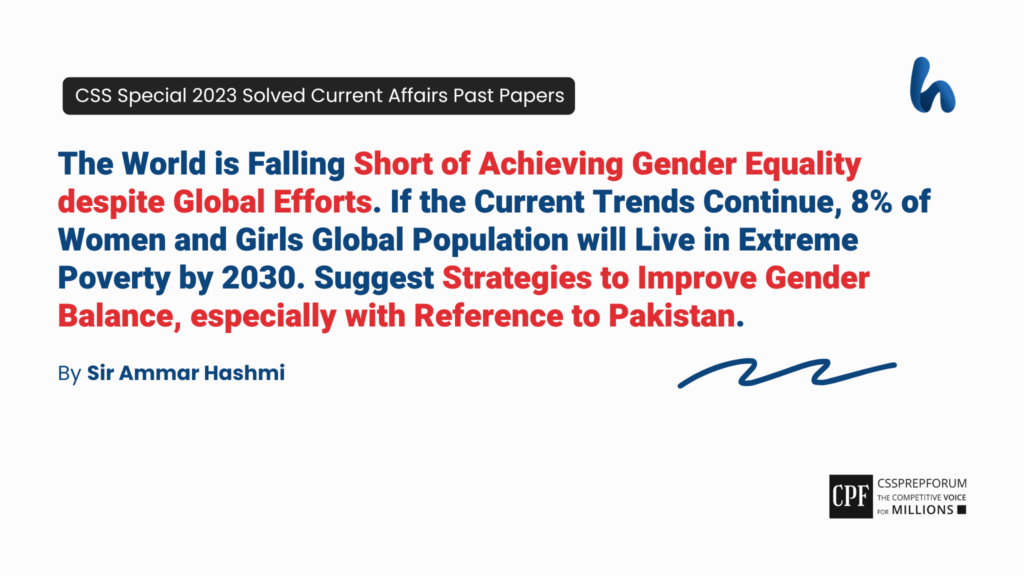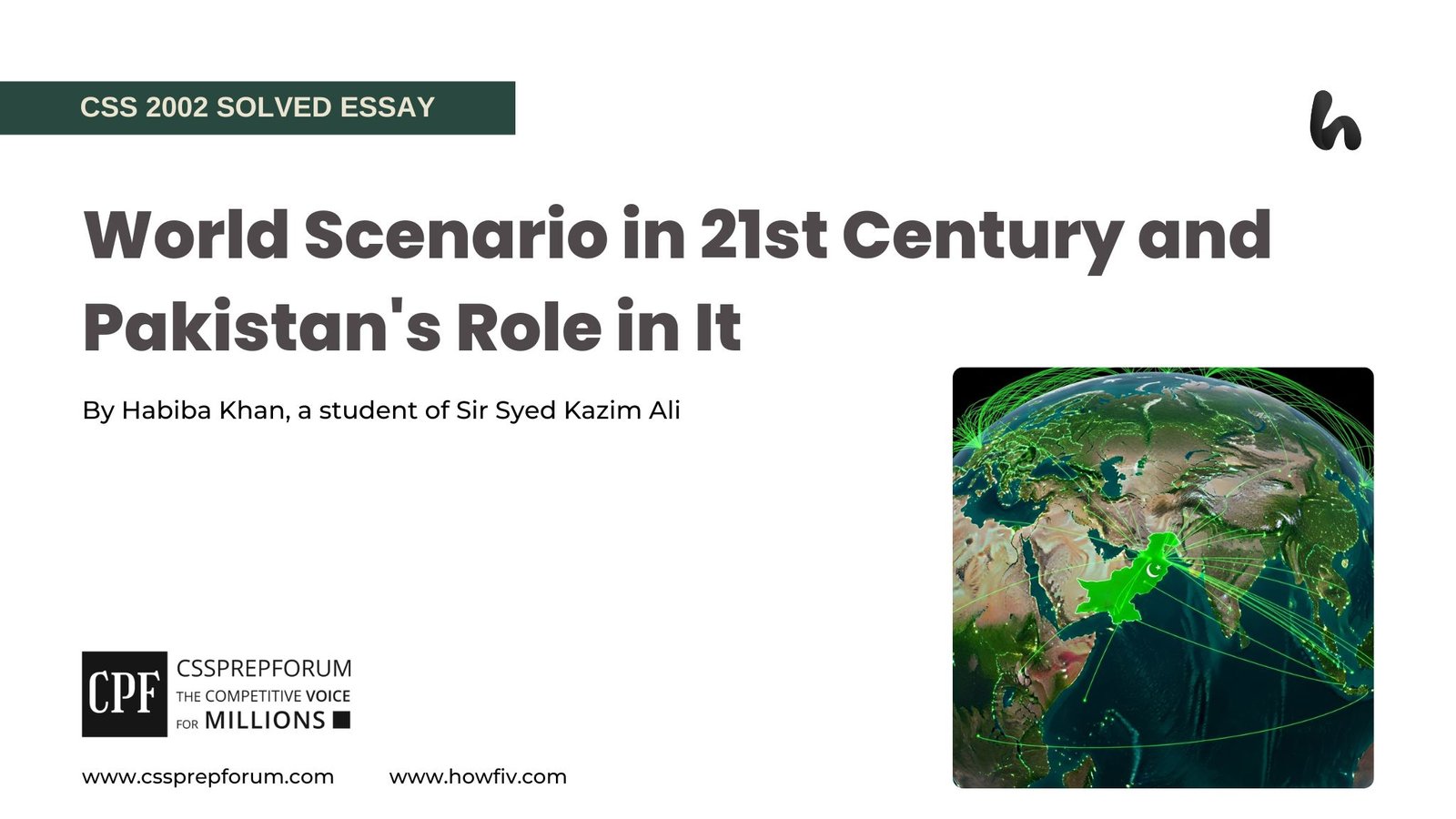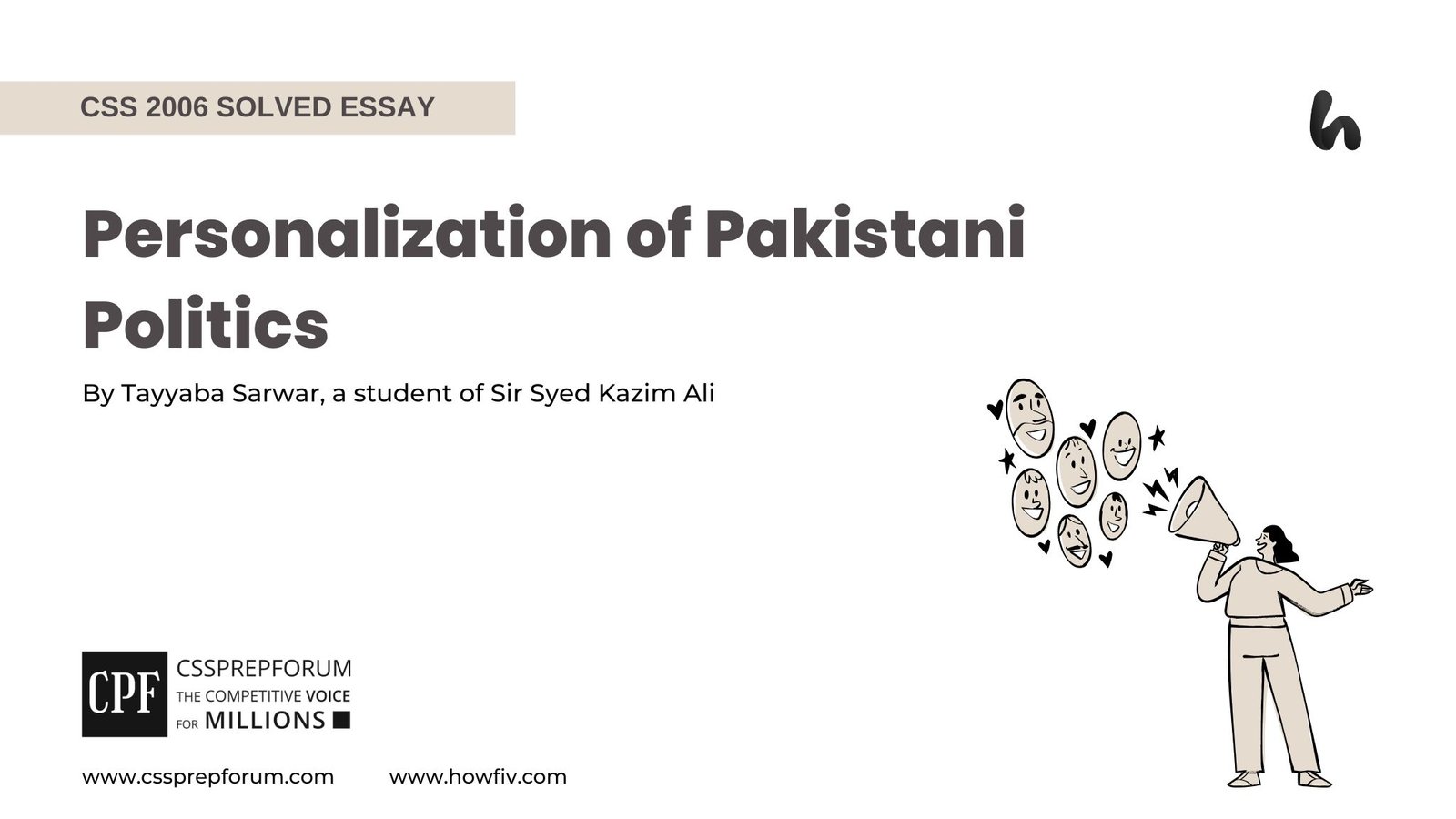CSS Special 2023 Solved Current Affairs Past Papers | Strategies to Improve Gender Balance in Pakistan
The following question of CSS Current Affairs 2023 Special is solved by Sir Ammar Hashmi, the best Current Affairs Coach, on the guided pattern of Sir Syed Kazim Ali, which he taught to his students, scoring the highest marks in compulsory subjects for years. This solved past paper question is uploaded to help aspirants understand how to crack a topic or question, how to write relevantly, what coherence is, and how to include and connect ideas, opinions, and suggestions to score the maximum.

Question Breakdown
This question has one part that requires strategies to improve gender balance wrt Pakistan. This question requires a brief description of unattained gender equality globally, which shows that 8% of women population would be under poverty by 2030. It also requires some practical strategies for Pakistan to attain maximum gender equality for economic and social development.
Outline
1-Introduction
2-Gender Equality at Risk: Global Trends show 8% of Global Girls Population to face extreme poverty by 2030.
3-Pakistan’s Gender Gap Statistics
4-Strategies to improve Gender Balance in Pakistan.
- ✓ Improvement in Access to Quality Education for Girls
- ✓ Provision of Better Reproductive and Maternal Health
- ✓ Strengthen the Law Against Gender-based Violence
- ✓ Enhancement of Women’s Political Participation and Leadership
- ✓ Constricting the Gender Wage Gap by implementing Equal Pay Policies
- ✓ Expansion of Women’s Economic Opportunities in Formal Sectors
5-Critical Analysis
6-Conclusion

Answer to the Question
Introduction
UN Secretary-General António Guterres stated,
“We are on the brink of seeing a rollback of decades of progress on gender equality. Immediate, transformative actions are required if we are to reverse this trend”
(UN Women, 2023)
In addition, violence against women remains a critical barrier to gender equality and economic success. Nearly 28% of women face domestic violence, as per the UN report, which further limits their access to opportunities and keeps them trapped in cycles of poverty. According to the World Economic Forum Global Gender Gap Report 2023, Pakistan was ranked 142 out of 146 countries for gender parity. In contrast, many countries have made progress in combating educational and health gaps. As remedial measures, only legislative reforms will not be successful without serious efforts to change societal attitudes that contribute towards women’s devaluation. Pakistan must also take successful global models as an example for future implementations like those in Rwanda and Bangladesh. Their strategies focus on both policy enforcement and social mobilization which provide valuable lessons to integrate women into the formal economy and political sphere. However, Pakistan’s diverse socio-cultural landscape demands an approach tailored to regional realities, especially in rural areas where resistance to gender equality is more common.
Gender Equality is at risk: Global Trends show that 8% of the Global Girls’ Population will face extreme poverty by 2030.
Global gender equality is significantly at risk, with the projection that 8% of females will live in extreme poverty by 2030. These statistics show that over 340 million women worldwide will be prone to severe economic hardship, particularly in underdeveloped regions like South Asia and Sub-Saharan Africa, where poverty rates are already high. This trend was accelerated by the COVID-19 pandemic, which has already pushed millions of women into poverty. UN Development Programme (UNDP) revealed in 2022 that COVID-19 disproportionately affected women and lost jobs at higher rates due to their concentration in retail, hospitality, and informal employment. Additionally, the International Labour Organization (ILO), in a report, unveiled that the primary driver of this economic disparity is the persistent gender wage gap, which stands at an average of 20 % globally, with women earning significantly less than men for the same job. This gap is more pronounced in low-income countries, like Pakistan, where the gender wage gap is 34% and women’s labour force participation hovers around 22 %. Other major factors are educational inequality, cultural norms, safety concerns, and a lack of infrastructure, which prevented many girls from attending school. This gap directly correlates with reduced earnings and economic vulnerability. Moreover, healthcare access is another area where women face notable inequalities, e.g. females have limited access to maternal healthcare and reproductive services, maternal mortality, etc. UN Secretary-General António Guterres stated,
“We are on the brink of seeing a rollback of decades of progress on gender equality. Immediate, transformative actions are required if we are to reverse this trend”
(UN Women, 2023)
In addition, violence against women remains a critical barrier to gender equality and economic success. Nearly 28% of women face domestic violence, as per the UN report, which further limits their access to opportunities and keeps them trapped in cycles of poverty. According to the World Economic Forum Global Gender Gap Report 2023, Pakistan was ranked 142 out of 146 countries for gender parity. In contrast, many countries have made progress in combating educational and health gaps. As 2030 is heading in a few years, achieving Sustainable Development Goal 5 (Gender Equality) remains elusive unless targeted and immediate interventions are made. Governments must prioritize women’s economic empowerment through policies that close the wage gap, improve access to education, and ensure better healthcare and legal protections.
Pakistan’s Gender Gap Statistics
Fig 1.1 shows the annual report on gender parity across four key dimensions: health and survival, economic participation and opportunity, political empowerment, and educational attainment. In this report, Pakistan ranks near the bottom of both the regional and global rankings, with only Afghanistan, Iran, Algeria, and Chad below it.

Source: Dawn. pk
Strategies to improve Gender Balance in Pakistan
- ✓ Improvement in Access to Quality Education for Girls:
According to UNICEF, Pakistan had 12 million girls out of school in 2023. The literacy rate is approximately 49% for women and 71 % for men, with women 20% lagging behind men (Pakistan Social and Living Standards Measurement Survey 2022). In rural areas, girls face additional challenges, including inadequate school infrastructure, cultural norms that discourage female education, and safety concerns during travel to schools. Some initiatives were taken to address these barriers, such as The Malala Fund, which has been active in Pakistan for girls’ education, especially in conflict-ridden and rural areas. Malala Yousafzai emphasized the importance of education for girls; she stated in one of the Malala Fund meetings in 2022,
“One child, one teacher, one book, one pen can change the world. Education is the only solution“.
Similarly, In Khyber Pakhtunkhwa (KPK), the government has invested in building more schools for girls, and in 2021, it also launched the “Girls’ Stipend Program” to financially provide incentives for families to send their daughters to school. To further curb gender parity in Pakistan, the government needs to invest in building more schools in underserved areas, increasing the number of trained female teachers, particularly in remote regions, implementing robust awareness campaigns to shift cultural norms, and strengthening partnerships between the government and international organizations to fund and monitor girls’ education programs.
- ✓ Provision of Better Reproductive and Maternal Health:
Pakistan faces significant barriers to accessing quality healthcare, especially in low-income areas, which leads to high maternal mortality rates and poor reproductive health. World Health Organization reported in 2023 that Pakistan’s maternal mortality rate stands at 186 deaths per 100,000 live births. This is higher than in similar countries such as Bangladesh (173) and Sri Lanka (36). Whereas UNFPA says that 1 in 3 women in Pakistan lack access to basic maternal health services, and there are not enough skilled birth attendants. Also, contraceptive use is low, which resulted in high rates of unplanned pregnancies, poor reproductive health outcomes and unsafe abortions. Despite these challenges, The Lady Health Workers (LHW) Program, launched in 1994, has made significant contributions since its inception by providing door-to-door healthcare services, which include maternal and reproductive health counselling sessions. In 2024, more than 100,000 lady health workers are delivering essential services to reduce maternal deaths and improve child health. Another notable organization working for the same cause is the Chhipa Welfare Association in Karachi; it provides free maternal healthcare services to women in low-income areas.
“No woman should die while giving life. The government is committed to ensuring every mother receives the care she needs,”
Dr. Zafar Mirza, a former health minister of Pakistan
To meet SDGs, Pakistan should increase investment in healthcare infrastructure and train and deploy more skilled healthcare professionals, obstetricians, midwives, and lady health workers to ensure that women receive quality care timely during pregnancy and childbirth. Also, expand access to family planning services by promoting contraception and reproductive health education, particularly for young women, and Integrate maternal healthcare into the broader healthcare system as a national health policy. Providing better access to these services will not only reduce the maternal mortality rate but also give women greater control over their reproductive lives to contribute more fully to Pakistan’s economic and social development.
- ✓ Strengthen the Law Against Gender-based Violence:
Gender-based violence (GBV) remains a widespread issue in Pakistan, with old patriarchal cultural norms, weak law enforcement, and a lack of resources to protect women from violence, harassment, and abuse. Human rights activist Asma Jahangir once said,
“Laws will not protect women until the society and state decide to implement them earnestly. Women cannot fight this battle alone”
As domestic violence remains pervasive. At the same time, laws exist to protect women, such as the Protection of Women Against Violence Act 2016. Still, enforcement remains weak due to a lack of resources and ingrains patriarchal norms that often prioritize family honour over justice for the victim.
Another alarming gender-based violence is honour killing; Human Rights Watch statistics for 2023 have also shown more than 1,000 women killed annually under the pretext of “family honour,” despite the Anti-Honor Killing Laws (2016) being passed to punish perpetrators. Still, loopholes in the justice system allow many cases to go unpunished. A lack of shelter homes and legal aid services also leaves many survivors without the necessary support to pursue justice. Recently, the Punjab Women Protection Authority (PWPA) was established to provide legal assistance, psychological support, and emergency shelter to victims of GBV. Also, the Convention on the Elimination of All Forms of Discrimination Against Women (CEDAW), to which Pakistan is a signatory, obligates it to enforce laws to protect women from violence. Still, Pakistan needs to establish more gender-sensitive police units and specialized courts, provide accessible and comprehensive support services and empower women legally and economically. Empowering women through law is not only a moral imperative but also a foundational step toward a more just and equitable society.
- ✓ Enhancement of Women’s Political Participation and Leadership:
Women have a strong and important voice in shaping policies that impact the politics and leadership of a nation. Women remain underrepresented in political leadership positions at different levels of government throughout the globe facing numerous barriers such as patriarchal norms, socio-economic challenges and lack of political support. Pakistan has recently seen a little increase in women’s participation in parliament; for instance, in national and provincial assemblies, the percentage has increased to 17%. However, this participation remains limited beyond these reserved seats; only 8% of directly elected seats were won by women in 2023, and general elections reflect the continued dominance of male political candidates. A Human Rights Watch report (2022) found that women in politics in Pakistan often face abuse, threats, and physical harassment, which creates a hostile environment for their involvement. In 2008, The Women’s Parliamentary Caucus was established, which served as a platform for women legislators to work across party lines to promote gender-sensitive policies, pushed for key legislation like the Anti-Harassment of Women at the Workplace Act (2010) and the Acid Control and Acid Crime Prevention Act (2011) showing the potential impact of women’s leadership on national policy. Countries like Rwanda have achieved gender parity in their politics, with 61% of seats held by women, which is a valuable model for Pakistan. The Inter-Parliamentary Union (IPU) ensures that countries with higher numbers of women in political leadership should pass more gender-sensitive policies, like women’s healthcare, education, and gender-based violence prevention. Likewise, Pakistan should increase political party support for women candidates by providing mentorship and funding, enforcing gender quotas beyond 17%, ensuring safe political participation by addressing violence, and developing support networks and mentorship programs to foster female leaders who can support each other in navigating the political landscape.
- ✓ Constricting the Gender Wage Gap by implementing Equal Pay Policies:
The wage disparity not only impacts women’s economic security but, on a broader scale, contributes to socio-economic inequalities in society. Pakistan Bureau of Statistics (2023) reported that women earn approximately 30-50% less than men in similar jobs. Factors contributing to the gender wage gap include occupational segregation, lack of transparency in pay structures and discrimination in hiring and promotions. Additionally, cultural attitudes that prioritize males in careers over females also perpetuate wage inequality. The Minimum Wage Policy mandates minimum pay standards across multiple sectors, but enforcement remains a challenge. Lately, there have been calls for raising the minimum salaries for women in sectors like domestic work or any other professional work where workers often earn less than the mandated amount. Moreover, organizations like the Aurat Foundation are working to advocate for policy changes to support equal pay for equal work and raise awareness about wage discrimination. Workshops are conducted to educate women about their rights and provide skills to negotiate better wages and working conditions. As stated by a women’s rights advocate, Shamim Naz,
“Equal pay for equal work is not just a moral obligation but an economic imperative for the development of our society”.
Several companies have adopted gender-neutral pay policies internationally to implement pay audits to identify and rectify wage disparities. Iceland and Norway have also made strides in closing the gender wage gap through the introduction of a pay equity law in 2018, under which companies are bound to pay men and women equally for the same work. Since then, Iceland has consistently ranked first in the Global Gender Gap Report for gender equality.
Pakistan should also implement equal pay legislation, conduct regular pay audits, encourage companies to adopt family-friendly policies and support women’s entrepreneurship through access to finance and mentorship programs.
- ✓ Expansion of Women’s Economic Opportunities in Formal Sectors:
Women’s participation in the formal economy remained low due to gender discrimination, socio-cultural barriers and limited access to education and skill training. By increasing women’s opportunities in multiple sectors, Pakistan can not only enhance gender equality but also drive sustainable development. In Pakistan, only 22% women are part of formal labor force compared to 81% men, where sectors such as agriculture and domestic work is dominated by women are generally outside the formal economy. Even in formal sectors, women are often related to low-paying roles, with fewer opportunities for career advancement. But, organizations like First Women Bank and Kashf Foundation offer microfinance and business support to female entrepreneurs which provide them with capital and skills necessary to formalize their businesses. In corporate sector, Habib Bank Limited (HBL) has introduced the HBL Nisa Program, focusing on improving financial inclusion for women and increasing female involvement in banking. Malala Yousafzai once stated,
“When women are educated and economically empowered, they strengthen entire communities”.
In this context, Bangladesh offers a compelling example for Pakistan, where women make up around 80% of the garment sector workforce significantly contributing to the country’s economy. Through policies aimed at improving women’s working conditions and providing skills training, Bangladesh has been able to formalize a large portion of this workforce. Similarly, in Rwanda, initiatives to increase women’s participation in formal sectors through skills training and financial inclusion programs have helped reduce poverty and narrow the gender gap. Pakistan should also invest in vocational and technical education programs, encourage private-sector companies to implement gender-inclusive hiring practices, promote flexible work arrangements and strengthen legal protections for women.
Critical Analysis
The success of aforementioned strategies depends on the government’s ability to move beyond gestures and adopt a multi-sectoral and coordinated approach. Gender equality requires an effective response that addresses health education, legal and economic inclusion simultaneously. Only legislative reforms will not be successful without serious efforts to change societal attitudes that contribute towards women’s devaluation. Pakistan must also take successful global models as examples for future implementations like, Rwanda and Bangladesh. Their strategies focus on both policy enforcement and social mobilization which provide valuable lessons to integrate women into formal economy and political sphere. However, Pakistan’s diverse socio-cultural landscape, demands an approach tailored according to regional realities especially rural areas where resistance to gender equality is more common. The private sector must also play a role in gender parity by implementing corporate social responsibility (CSR) initiatives which mainly focuses gender equality e.g. gender-neutral hiring practices, and leadership development programs for women. With commitment and consistency these strategies have the potential to not only uplift women but also unlock its broader economic potential.
Conclusion
Pakistan is in need of a multifaceted approach that should target the cultural, structural and socio-economic barriers faced by women. Improvement in access to quality education and reproductive and maternal health, strengthening of law and legal protections against GBV, promotion of female in political participation, curbing gender wage gap and providing women economic opportunities are critical to narrow the gender gap. The country must commit to a sustainable and holistic approach that fearlessly challenge patriarchal norms and enforce law and provide rights. Improving gender differences will significantly boost economic growth and societal well-being and will help Pakistan to fulfill its commitments closer to fulfilling its global commitments to Sustainable Development Goals (SDGs).

CSS 2023 Special Solved Current Affairs
CSS Solved Past Papers’ Essays
Looking for the last ten years of CSS and PMS Solved Essays and want to know how Sir Kazim’s students write and score the highest marks in the essays’ papers? Then, click on the CSS Solved Essays to start reading them.
CSS Solved Essays
CSS Solved General Science & Ability Past Papers
Want to read the last ten years’ General Science & Ability Solved Past Papers to learn how to attempt them and to score high? Let’s click on the link below to read them all freely. All past papers have been solved by Pakistan’s top CSS GSA coach having the highest score of their students.
General Science & Ability Solved Past Paper












